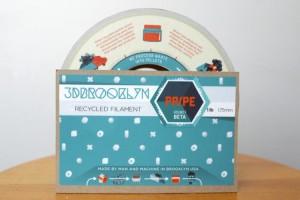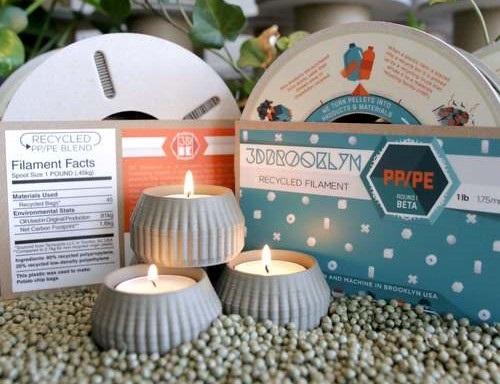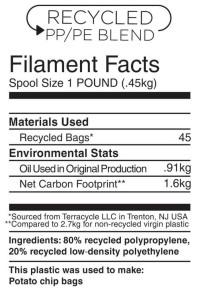 Potato chips are a guilty pleasure for a lot of people. I hardly ever buy them, in keeping with my philosophy of “if you eat healthy at home, you can eat terribly elsewhere.” I tend to attack them at parties, though. No matter how frequently you buy or eat them, potato chips are everywhere, along with their weird, shiny, crinkly packaging. Is it plastic? Is it foil? It is plastic, but it’s an odd hybrid of polypropylene and polyethylene that makes up those metallic pouches capable of blinding you if the sun hits them a certain way. Unlike most plastics, potato chip bags’ blended plastic properties make them unfit for recycling – that’s a lot of greasy shiny material going to the landfills.
Potato chips are a guilty pleasure for a lot of people. I hardly ever buy them, in keeping with my philosophy of “if you eat healthy at home, you can eat terribly elsewhere.” I tend to attack them at parties, though. No matter how frequently you buy or eat them, potato chips are everywhere, along with their weird, shiny, crinkly packaging. Is it plastic? Is it foil? It is plastic, but it’s an odd hybrid of polypropylene and polyethylene that makes up those metallic pouches capable of blinding you if the sun hits them a certain way. Unlike most plastics, potato chip bags’ blended plastic properties make them unfit for recycling – that’s a lot of greasy shiny material going to the landfills.
Unfortunately, there are a lot of disposable products that are unfit for recycling, and that’s why companies like TerraCycle exist. The New Jersey company collects nonrecyclable or hard to recycle waste and figures out ways to recycle or repurpose it. They were the first resource that came to mind for Will Haude, founder of 3D Brooklyn, when he began to feel bothered by the amount of plastic waste his company generated. He wondered why his company, which manufactures custom 3D printed items from electronic accessories to planters, couldn’t start reducing rather than generating plastic waste.
When 3D Brooklyn reached out to TerraCycle, the company told them about the massive influx of potato chip bags they receive from a supplier. Once received, TerraCycle shreds the bags and sends them to a third party, who transforms them into plastic pellets – perfect, 3D Brooklyn realized, for turning into filament. They purchased a large amount of the pellets from TerraCycle, put them into a filament extruder, and thus 3D Brooklyn’s first recycled filament product was born.
The filament, which is currently in beta launch, is priced at $24 per one-pound spool. Each spool is made from about 45 recycled chip bags, and consists of 80% recycled polypropylene, and 20% recycled low density polyethylene. Brief printing guidelines suggest:
- Printing temperature: 210°
- Heated bed: 110°
- Infill: 50%
According to 3D Brooklyn, the PP/PE filament generates prints with a “durable wicker furniture feel.” The color vaguely resembles wicker, too – sorry, no blindingly shiny objects here; the chip bags’ metallic properties were lost during processing. Why not try it? Recycled filaments are becoming more popular, as consumers and companies look for ways to reduce the amount of plastic generated by 3D printing. As Haude points out, their new filament is made from material that is being pulled directly out of a landfill. So the next time you tear open a bag of potato chips, you can feel a little less guilty – about the packaging, at any rate. Have you tested this new filament out for yourself? Let us know your thoughts in the Potato Chip Bag Filament forum thread on 3DPB.com.
Subscribe to Our Email Newsletter
Stay up-to-date on all the latest news from the 3D printing industry and receive information and offers from third party vendors.
You May Also Like
Nylon 3D Printed Parts Made More Functional with Coatings & Colors
Parts 3D printed from polyamide (PA, Nylon) 12 using powder bed fusion (PBF) are a mainstay in the additive manufacturing (AM) industry. While post-finishing processes have improved the porosity of...
3DPOD Episode 193: Flow and What’s Possible in 3D Printing with Ricky Wildman, University of Nottingham
Ricky Wildman is working on 3D printing pills, but, as Professor of Multiphase Flow and Physics at Nottingham, he does a whole lot more. His research encompasses the characterization of...
3D Printing Webinar and Event Roundup: March 17, 2024
It’s another busy week of webinars and events, including SALMED 2024 and AM Forum in Berlin. Stratasys continues its in-person training and is offering two webinars, ASTM is holding a...
3D Printed Micro Antenna is 15% Smaller and 6X Lighter
Horizon Microtechnologies has achieved success in creating a high-frequency D-Band horn antenna through micro 3D printing. However, this achievement did not rely solely on 3D printing; it involved a combination...































